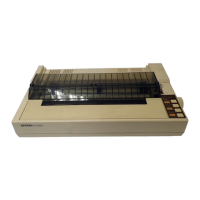REV.-A
● CPU Timing
Refer to Figures A-3
through A-5 for CPU timing diagrams.
Three oscillations define one state. The OP code fetch requires four states; during TI to
T3, program
memory is read; instructions are interpreted during
T4. Address bus lines 15-8 are output from
T1
to
T4. Address but lines 7-O
(PD7-0)
are used in the multiplex mode; the address is latched during T1 at
the ALE signal. Since the memory addressed is enabled after disengaging the driver (AD7-0),
~
is output
from
T1
-T3,
fetched at T3, and processed internally at T4. The ALE and RD signals are executed from
T1-T3; the OP code fetch for these two signals is performed at T4. The WR signal is output from the
middle of T 1 to the beginning of
T3. The address and ALE timing is the same as that for memory read;
however following address output
AD7-O
(PD7-0)
are not disabled, and write data is output at
AD7-O
at the beginning of
T1
and the end of T3.
NOTE: When
PD7-O
are set to the multiplexed address/data-bus (AD7-0) to the address bus
(AB7-0),
the
~
and WR signals in the machine cycle are HIGH when memory is not being accessed.
CLOCK
ALE
/
AB15 -8
(PF7
-O)
Y
ADDRESS
x
AD7 -o
(PD7
-O)
x
ADDRESS
}-
---<
OP CODE
>---c
Figure A-3. OP Code Fetch Timing
T1
T2
T3
CLOCK
~
AB15 -8
(PF7
-0)
x
ADDRESS
x
AD7
-o
(PD7
-O)
x
ADDRESS
}-
--<
READ DATA
>---
c
Figure A-4. Memory Read Timing
CLOCK
AB15 -8
(PF7
-0)
x
ADDRESS
AD7
-0
(PD7
-0)
x
ADDRESS
x
x
WRITE DATA
Figure A-5.
Memory Write Timing
A-6
“[’’’””

